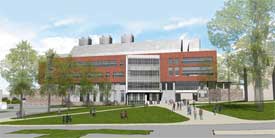 October 4, 2010 — Lincoln, R.I. — Supporters of Rhode Island bond referendum Question 2 detailed just how essential the “yes” vote on Nov. 2 is for the state’s future during a campaign kickoff today at the ChemArt Company in Lincoln. Approval will bring a new Center for Chemical and Forensic Sciences to the University of Rhode Island, improve the Arts Center at Rhode Island College, and build the capacity to generate new employers and create new jobs now and in the future.
October 4, 2010 — Lincoln, R.I. — Supporters of Rhode Island bond referendum Question 2 detailed just how essential the “yes” vote on Nov. 2 is for the state’s future during a campaign kickoff today at the ChemArt Company in Lincoln. Approval will bring a new Center for Chemical and Forensic Sciences to the University of Rhode Island, improve the Arts Center at Rhode Island College, and build the capacity to generate new employers and create new jobs now and in the future.
Rhode Islanders will be asked to vote on a $78 million higher education bond referendum (#2) that includes $61 million to finance a new Center for Chemical and Forensic Sciences at URI and $17 million for an addition to the RIC Art Center.
“We’re not just asking to build a physical infrastructure with leading edge teaching and research space, we are asking to build the sustainable supply of human talent and human ingenuity that is necessary to drive innovation, to drive the frontiers forward in research and discovery,” said URI President David M. Dooley. “Chemistry is the foundation to many vital research and teaching endeavors and future jobs, whether it’s in the health sciences, biotechnology, energy, the environment, pharmacy, nursing or high technology. Chemistry is the building block, the bedrock foundation.”
If approved, referendum 2 will create approximately 1,200 jobs over the next five years in construction, trades, architecture, engineering, management, teaching and research. When completed, the new chemistry center will allow faculty to compete more effectively for research grants, and move scientific discoveries into the marketplace more rapidly.
Center for Chemical and Forensic Sciences
Chemistry is now being taught in URI’s Pastore Hall, which was built in 1953 to accommodate about 800 students. Today, there are more than 6,000 students taking chemistry annually. In fact, about 40 percent of all URI degree programs require at least one chemistry class. The lack of teaching and research lab space has created a bottleneck that has hampered growth in pharmacy, biotechnology, engineering, and many other fields.
Twice the size of Pastore, the proposed 120,000-square-foot, four-story center will have triple the amount of space for teaching labs and nearly double the space for research labs. The total student capacity in laboratories will increase by more than 50 percent, from 1,200 to 1,900 students per semester.
The proposed Center will be a core education facility, joining the new College of Pharmacy, the Center for Biotechnology and Life Sciences, and the College of Nursing to complete the North Science Quadrangle on the Kingston Campus and strengthen the University’s leadership position in the health and life sciences.
Chemistry faculty already lead in such areas as developing advanced batteries to fuel energy efficient automobiles, improving resolution in magnetic resonance imaging (MRI) scans, and creating new clinical methods for earlier disease detection. In addition, the Center will be the headquarters for the U.S. Department of Homeland Security’s Center of Excellence in Explosives Detection, Mitigation, and Response that serves as one of the nation’s key resources for research and training in the battle against terrorism.
“People do ask how this project is connected to creating jobs in Rhode Island,” says Dooley. “My response is that in addition to building the 21st century workforce in the state, we need to build the capacity to generate new employers – that is how you create new jobs. The kind of activity that will take place in this facility will encourage innovation and the application of those discoveries – the pathway to new growth and economic development.
“This building is designed to last 50 years,” adds Dooley, “and chemistry will continue to be the science behind many of the frontiers that will be so important for the 21st century.”
Rhode Island College, Arts Center
Bond referendum 2 also will provide $17 million to support building an addition onto and renovation of Rhode Island College’s 52-year-old Art Center.
“RIC’s art program as well as its students and faculty are highly regarded. Our goal is to provide an appropriate working environment for their fine creative work,” said Rhode Island College President Nancy Carriuolo.
The Arts Center houses RIC’s entire Department of Art. It is the location for all of the studio arts and arts education courses and related programs. About 2,000 students take one or more of the 130 classes offered each year. The art degree-granting programs currently serve about 240 undergraduate majors, 30 minors and 25 graduate students.
Built in 1958, the 34,000-square-foot facility was designed to house the student center, dining center, bookstore and library. Now the facility consists of classrooms, studios, and offices for the art department, yet it does not adequately meet the requirements of the academic program — including the need for areas to publicly exhibit student works. In addition to space redesign and improvements, the Arts Center requires a host of renovations to meet current health and safety codes for continued use.
For more information go to http://essential2ri.org/YesOn2/
Speakers at the kickoff rally included Rhode Island Commissioner of Higher Education Ray Di Pasquale, URI President David M. Dooley, RIC President Nancy Carriuolo, ChemArt founder and CEO Richard Beaupre URI ’62, and students from URI and RIC.

